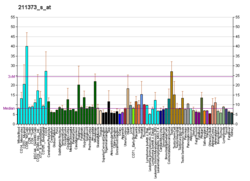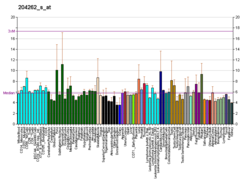Presenilin-2
Presenilin-2 is a protein that (in humans) is encoded by the PSEN2 gene.[5]
Function
[edit]Alzheimer's disease (AD) patients with an inherited form of the disease carry mutations in the presenilin proteins (PSEN1; PSEN2) or the amyloid precursor protein (APP). These disease-linked mutations result in increased production of the longer form of amyloid-beta (main component of amyloid deposits found in AD brains). Presenilins are postulated to regulate APP processing through their effects on gamma-secretase, an enzyme that cleaves APP. Also, it is thought that the presenilins are involved in the cleavage of the Notch receptor, such that they either directly regulate gamma-secretase activity or themselves are protease enzymes. Two alternative transcripts of PSEN2 have been identified.[6]
In melanocytic cells PSEN2 gene expression may be regulated by MITF.[7]
Interactions
[edit]PSEN2 has been shown to interact with:
References
[edit]- ^ a b c GRCh38: Ensembl release 89: ENSG00000143801 – Ensembl, May 2017
- ^ a b c GRCm38: Ensembl release 89: ENSMUSG00000010609 – Ensembl, May 2017
- ^ "Human PubMed Reference:". National Center for Biotechnology Information, U.S. National Library of Medicine.
- ^ "Mouse PubMed Reference:". National Center for Biotechnology Information, U.S. National Library of Medicine.
- ^ Levy-Lahad E, Wasco W, Poorkaj P, Romano DM, Oshima J, Pettingell WH, Yu CE, Jondro PD, Schmidt SD, Wang K (September 1995). "Candidate gene for the chromosome 1 familial Alzheimer's disease locus". Science. 269 (5226): 973–977. Bibcode:1995Sci...269..973L. doi:10.1126/science.7638622. PMID 7638622. S2CID 27296868.
- ^ "Entrez Gene: PSEN2 presenilin 2 (Alzheimer disease 4)".
- ^ Hoek KS, Schlegel NC, Eichhoff OM, Widmer DS, Praetorius C, Einarsson SO, Valgeirsdottir S, Bergsteinsdottir K, Schepsky A, Dummer R, Steingrimsson E (2008). "Novel MITF targets identified using a two-step DNA microarray strategy". Pigment Cell Melanoma Res. 21 (6): 665–676. doi:10.1111/j.1755-148X.2008.00505.x. PMID 19067971.
- ^ Passer BJ, Pellegrini L, Vito P, Ganjei JK, D'Adamio L (August 1999). "Interaction of Alzheimer's presenilin-1 and presenilin-2 with Bcl-X(L). A potential role in modulating the threshold of cell death". J. Biol. Chem. 274 (34): 24007–13. doi:10.1074/jbc.274.34.24007. PMID 10446169.
- ^ Shinozaki K, Maruyama K, Kume H, Tomita T, Saido TC, Iwatsubo T, Obata K (May 1998). "The presenilin 2 loop domain interacts with the mu-calpain C-terminal region". Int. J. Mol. Med. 1 (5): 797–9. doi:10.3892/ijmm.1.5.797. PMID 9852298.
- ^ Stabler SM, Ostrowski LL, Janicki SM, Monteiro MJ (June 1999). "A myristoylated calcium-binding protein that preferentially interacts with the Alzheimer's disease presenilin 2 protein". J. Cell Biol. 145 (6): 1277–92. doi:10.1083/jcb.145.6.1277. PMC 2133148. PMID 10366599.
- ^ Buxbaum JD, Choi EK, Luo Y, Lilliehook C, Crowley AC, Merriam DE, Wasco W (October 1998). "Calsenilin: a calcium-binding protein that interacts with the presenilins and regulates the levels of a presenilin fragment". Nat. Med. 4 (10): 1177–81. doi:10.1038/2673. PMID 9771752. S2CID 10799492.
- ^ Choi EK, Zaidi NF, Miller JS, Crowley AC, Merriam DE, Lilliehook C, Buxbaum JD, Wasco W (June 2001). "Calsenilin is a substrate for caspase-3 that preferentially interacts with the familial Alzheimer's disease-associated C-terminal fragment of presenilin 2". J. Biol. Chem. 276 (22): 19197–204. doi:10.1074/jbc.M008597200. PMID 11278424.
- ^ Tanahashi H, Tabira T (September 2000). "Alzheimer's disease-associated presenilin 2 interacts with DRAL, an LIM-domain protein". Hum. Mol. Genet. 9 (15): 2281–9. doi:10.1093/oxfordjournals.hmg.a018919. PMID 11001931.
- ^ Zhang W, Han SW, McKeel DW, Goate A, Wu JY (February 1998). "Interaction of presenilins with the filamin family of actin-binding proteins". J. Neurosci. 18 (3): 914–22. doi:10.1523/JNEUROSCI.18-03-00914.1998. PMC 2042137. PMID 9437013.
- ^ Morohashi Y, Hatano N, Ohya S, Takikawa R, Watabiki T, Takasugi N, Imaizumi Y, Tomita T, Iwatsubo T (April 2002). "Molecular cloning and characterization of CALP/KChIP4, a novel EF-hand protein interacting with presenilin 2 and voltage-gated potassium channel subunit Kv4". J. Biol. Chem. 277 (17): 14965–75. doi:10.1074/jbc.M200897200. PMID 11847232.
- ^ Lee SF, Shah S, Li H, Yu C, Han W, Yu G (November 2002). "Mammalian APH-1 interacts with presenilin and nicastrin and is required for intramembrane proteolysis of amyloid-beta precursor protein and Notch". J. Biol. Chem. 277 (47): 45013–9. doi:10.1074/jbc.M208164200. PMID 12297508.
- ^ Yu G, Nishimura M, Arawaka S, Levitan D, Zhang L, Tandon A, Song YQ, Rogaeva E, Chen F, Kawarai T, Supala A, Levesque L, Yu H, Yang DS, Holmes E, Milman P, Liang Y, Zhang DM, Xu DH, Sato C, Rogaev E, Smith M, Janus C, Zhang Y, Aebersold R, Farrer LS, Sorbi S, Bruni A, Fraser P, St George-Hyslop P (September 2000). "Nicastrin modulates presenilin-mediated notch/glp-1 signal transduction and betaAPP processing". Nature. 407 (6800): 48–54. Bibcode:2000Natur.407...48Y. doi:10.1038/35024009. PMID 10993067. S2CID 4339220.
- ^ Mah AL, Perry G, Smith MA, Monteiro MJ (November 2000). "Identification of ubiquilin, a novel presenilin interactor that increases presenilin protein accumulation". J. Cell Biol. 151 (4): 847–62. doi:10.1083/jcb.151.4.847. PMC 2169435. PMID 11076969.
Further reading
[edit]- Cruts M, Van Broeckhoven C (1998). "Presenilin mutations in Alzheimer's disease". Hum. Mutat. 11 (3): 183–190. doi:10.1002/(SICI)1098-1004(1998)11:3<183::AID-HUMU1>3.0.CO;2-J. PMID 9521418. S2CID 37870910.
- McGeer PL, Kawamata T, McGeer EG (1998). "Localization and possible functions of presenilins in brain". Reviews in the Neurosciences. 9 (1): 1–15. doi:10.1515/REVNEURO.1998.9.1.1. PMID 9683324. S2CID 22791458.
- Nishimura M, Yu G, St George-Hyslop PH (1999). "Biology of presenilins as causative molecules for Alzheimer disease". Clin. Genet. 55 (4): 219–225. doi:10.1034/j.1399-0004.1999.550401.x. PMID 10361981. S2CID 35128500.
- da Costa CA (2006). "Recent insights on the pro-apoptotic phenotype elicited by presenilin 2 and its caspase and presenilinase-derived fragments". Current Alzheimer Research. 2 (5): 507–514. doi:10.2174/156720505774932278. PMID 16375654.
- Wolfe MS (2007). "When loss is gain: reduced presenilin proteolytic function leads to increased Abeta42/Abeta40. Talking Point on the role of presenilin mutations in Alzheimer disease". EMBO Rep. 8 (2): 136–140. doi:10.1038/sj.embor.7400896. PMC 1796780. PMID 17268504.
- De Strooper B (2007). "Loss-of-function presenilin mutations in Alzheimer disease. Talking Point on the role of presenilin mutations in Alzheimer disease". EMBO Rep. 8 (2): 141–146. doi:10.1038/sj.embor.7400897. PMC 1796779. PMID 17268505.
External links
[edit]







